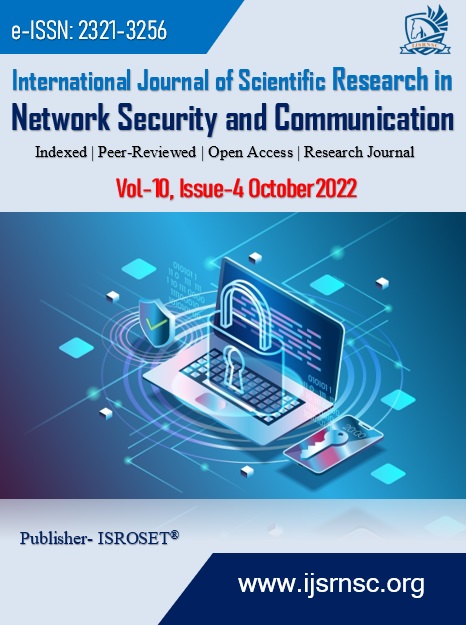Application of Adaptive Neuro-Fuzzy Inference Systems in Mobile’s Spam
Keywords:
Mobile Spam Classification, ANFIS, Back Propagation, Ginis Index, Training Iterations, Classification AccuracyAbstract
The function of science is to explain reality logically. With the increased usage of the internet, spamming is the most typical problem that we faced every day. Service of mailing and web applications are much spammed, nowadays this expansion in the number of spam messages has turned into a significant issue. Accessibility of messaging services for a minimal price has come about in the expansion of spam messages. Spam location is attempting a direct result of the necessity for semantic analysis of the compact spam messages, which overall will for the most part have overlapping polarities. In this work, a portable spam order strategy is created in light of an Adaptive Neuro Inference System(ANFIS) containing Gini record fuzzy and Back-Propagation in machine learning. The methodology includes Gini’s index models for information indexes and a back-propagation-based neural network as the AI classifier. This paper presents the assessment of the introduced system based on the error, accuracy of classification, and the number of iterations.
References
A. K. Jain, D. Goel, S. Agarwal, Y. Singh, and G. Bajaj, “Predicting Spam Messages Using Back Propagation Neural Network,” Wirel. Pers. Commun., Vol.110, Issue.1, pp.403–422, 2020, doi: 10.1007/s11277-019-06734-y.
K. S. Adewole, N. B. Anuar, A. Kamsin, and A. K. Sangaiah, “SMSAD: a framework for spam message and spam account detection,” Multimed. Tools Appl., Vol.78, Issue.4, pp.3925–3960, 2019, doi: 10.1007/s11042-017-5018-x.
N. Mirza, B. Patil, T. Mirza, and R. Auti, “Evaluating efficiency of classifier for email spam detector using hybrid feature selection approaches,” Proc. 2017 Int. Conf. Intell. Comput. Control Syst. ICICCS 2017, Vol.2018, pp.735–740, 2017, doi: 10.1109/ICCONS.2017.8250561.
K. Hans, L. Ahuja, and S. K. Muttoo, “Detecting redirection spam using multilayer perceptron neural network,” Soft Comput., Vol.21, Issue.13, pp.3803–3814, 2017, doi: 10.1007/s00500-017-2531-9.
A. K. Jain, D. Goel, S. Agarwal, Y. Singh, and G. Bajaj, “Predicting Spam Messages Using Back Propagation Neural Network,” Wirel. Pers. Commun., Vol.110, Issue.1, pp.403–422, 2020, doi: 10.1007/s11277-019-06734-y.
S. Sedhai and A. Sun, “Semi-Supervised Spam Detection in Twitter Stream,” IEEE Trans. Comput. Soc. Syst., Vol.5, Issue.1, pp.169–175, 2018, doi: 10.1109/TCSS.2017.2773581.
H. Afzal and K. Mehmood, “Spam filtering of bi-lingual tweets using machine learning,” Int. Conf. Adv. Commun. Technol. ICACT, Vol.2016, pp.710–714, 2016, doi: 10.1109/ICACT.2016.7423530.
C. Chen, Y. Wang, J. Zhang, Y. Xiang, W. Zhou, and G. Min, “Statistical Features-Based Real-Time Detection of Drifted Twitter Spam,” IEEE Trans. Inf. Forensics Secur., Vol.12, Issue.4, pp.914–925, 2017, doi: 10.1109/TIFS.2016.2621888.
T. Vyas, P. Prajapati, and S. Gadhwal, “A survey and evaluation of supervised machine learning techniques for spam e-mail filtering,” Proc. 2015 IEEE Int. Conf. Electr. Comput. Commun. Technol. ICECCT, 2015, doi: 10.1109/ICECCT.2015.7226077.
N. Jatana, “Radix Encoded Fragmented Database Approach,” pp.939–942, 2014.
K. Kandasamy and P. Koroth, “An integrated approach to spam classification on Twitter using URL analysis, natural language processing and machine learning techniques,” 2014 IEEE Students’ Conf. Electr. Electron. Comput. Sci. SCEECS 2014, 2014, doi: 10.1109/SCEECS.2014.6804508.
N. Prasad, R. Singh, and S. P. Lal, “Comparison of back propagation and resilient propagation algorithm for spam classification,” Proc. Int. Conf. Comput. Intell. Model. Simul., pp.29–34, 2013, doi: 10.1109/CIMSim.2013.14.
A. Rajadesingan and A. Mahendran, “Comment spam classification in blogs through comment analysis and comment-blog post relationships,” Lect. Notes Comput. Sci. (including Subser. Lect. Notes Artif. Intell. Lect. Notes Bioinformatics), Vol.7182. no. PART 2, pp.490–501, 2012, doi: 10.1007/978-3-642-28601-8_41.
A. K. Uysal, S. Gunal, S. Ergin, and E. S. Gunal, “A novel framework for SMS spam filtering,” INISTA 2012 - Int. Symp. Innov. Intell. Syst. Appl., 2012, doi: 10.1109/INISTA.2012.6246947.
S. Vahora, M. Hasan, and R. Lakhani, “Novel approach: Naïve Bayes with vector space model for spam classification,” 2011 Nirma Univ. Int. Conf. Eng. Curr. Trends Technol. NUiCONE 2011 - Conf. Proc., pp.11–15, 2011, doi: 10.1109/NUiConE.2011.6153245.
L. Araujo and J. Martinez-Romo, “Web spam detection: New classification features based on qualified link analysis and language models,” IEEE Trans. Inf. Forensics Secur., Vol.5, Issue.3, pp.581–590, 2010, doi: 10.1109/TIFS.2010.2050767.
S. M. Lee, D. S. Kim, J. H. Kim, and J. S. Park, “Spam detection using feature selection and parameters optimization,” CISIS 2010 - 4th Int. Conf. Complex, Intell. Softw. Intensive Syst., no. i, pp.883–888, 2010, doi: 10.1109/CISIS.2010.116.
C. Y. Tseng and M. S. Chen, “Incremental SVM model for spam detection on dynamic email social networks,” Proc. - 12th IEEE Int. Conf. Comput. Sci. Eng. CSE 2009, Vol.4, pp.128–135, 2009, doi: 10.1109/CSE.2009.260.
Downloads
Published
How to Cite
Issue
Section
License

This work is licensed under a Creative Commons Attribution 4.0 International License.
Authors contributing to this journal agree to publish their articles under the Creative Commons Attribution 4.0 International License, allowing third parties to share their work (copy, distribute, transmit) and to adapt it, under the condition that the authors are given credit and that in the event of reuse or distribution, the terms of this license are made clear.









